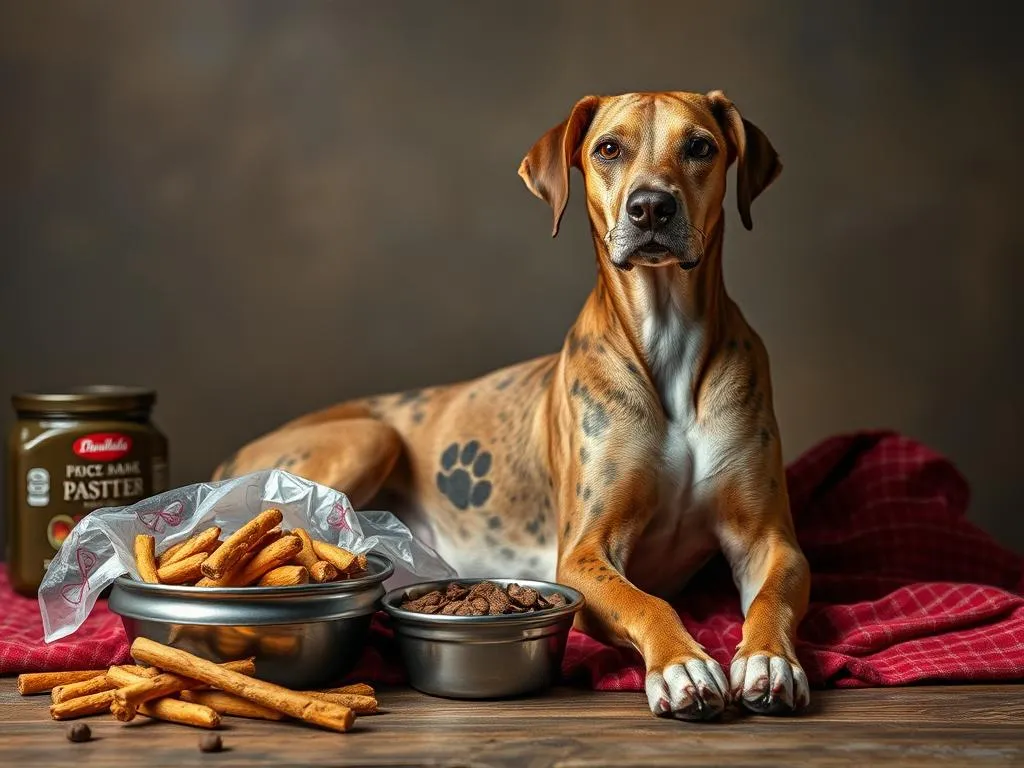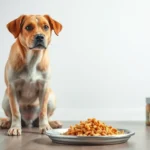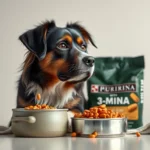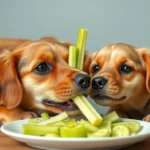
Introduction
Great Danes, often referred to as the “gentle giants” of the dog world, are known for their impressive size, elegant stature, and friendly demeanor. Originating from Germany, this breed was initially bred to hunt wild boars and protect estates. Their historical role has contributed to their strong build and noble appearance. Adult Great Danes typically weigh between 110 to 175 pounds and stand between 28 to 34 inches tall at the shoulder.
Given their size, proper nutrition for Great Danes is critical not just for maintaining a healthy weight but also for supporting their overall health and longevity. A well-balanced diet can significantly impact their lifespan and quality of life, while poor nutrition may lead to common health issues such as hip dysplasia, heart disease, and obesity.
This article serves as a comprehensive guide on selecting the best dog foods for Great Danes, ensuring that they receive the nutrition they need to thrive.
Understanding the Nutritional Needs of Great Danes
Macronutrients
Proteins
Proteins are essential for Great Danes due to their rapid growth and large muscle mass. They should ideally receive high-quality protein sources, such as chicken, beef, lamb, or fish. Look for dog foods that list real meat as the first ingredient, as this ensures a higher protein content necessary for muscle development and overall health.
Fats
Fats are a vital energy source for Great Danes. They play a significant role in maintaining healthy skin and a shiny coat. Look for foods that contain healthy fats from sources such as fish oil or chicken fat. An adequate amount of omega fatty acids is particularly important for joint health, which is a concern for large breeds.
Carbohydrates
While proteins and fats are crucial, carbohydrates also play an essential role in a balanced diet. They provide energy and support digestive health. Opt for easily digestible carbohydrates such as sweet potatoes, brown rice, and oats. Avoid fillers like corn and soy, which offer little nutritional value.
Micronutrients
Vitamins
Certain vitamins are vital for the growth and maintenance of Great Danes. Key vitamins include:
- Vitamin A: Supports vision and immune function.
- Vitamin D: Crucial for calcium absorption and bone health.
- Vitamin E: Acts as an antioxidant, supporting skin health.
Minerals
Minerals are equally important, especially for large breeds like Great Danes. Key minerals include:
- Calcium: Essential for bone health, particularly in puppies.
- Phosphorus: Works together with calcium to promote strong bones.
- Potassium: Supports muscle function and fluid balance.
Special Dietary Considerations
Age-specific Needs
Great Danes have different nutritional requirements at various life stages. Puppies require a diet rich in calories and nutrients to support their rapid growth, while adult dogs need a balanced diet to maintain a healthy weight. Senior Great Danes may benefit from a diet lower in calories but higher in joint-supporting ingredients.
Weight Management
Due to their size, Great Danes can be prone to obesity. It is crucial to monitor their weight and adjust their diet accordingly. Look for dog foods specifically formulated for large breeds that focus on maintaining a healthy weight.
Sensitivities and Allergies
Some Great Danes may suffer from food sensitivities or allergies. Common allergens include beef, chicken, dairy, and grains. If your dog shows signs of allergies, consider consulting with a veterinarian for an elimination diet.
Key Factors to Consider When Choosing Dog Food
Ingredients Quality
The quality of ingredients in dog food is paramount. Whole food sources, such as real meat and vegetables, should take precedence over by-products. When selecting dog food, check the ingredient list to ensure it contains high-quality proteins and whole grains or vegetables.
Grain-free vs. Grain-inclusive Diets
The debate between grain-free and grain-inclusive diets continues. Some owners prefer grain-free options, believing they are better for their dogs’ digestive health. However, many Great Danes can digest grains without issues. It’s essential to observe how your dog reacts to different diets and consult a veterinarian for tailored advice.
Dog Food Types
Dry Kibble
Dry kibble is popular for its convenience and shelf stability. Look for high-quality kibble formulated for large breeds, containing appropriate protein and fat levels.
Wet Food
Wet food can be more palatable for some dogs and provides additional hydration. However, it can be more expensive and less convenient for storage.
Raw Diets
Raw diets, often called “BARF” (biologically appropriate raw food), consist of raw meat, bones, fruits, and vegetables. While some owners advocate for raw diets, they require careful planning to ensure balanced nutrition.
Homemade Diets
Homemade diets allow for complete control over ingredients but require careful planning to avoid nutritional imbalances. Consult a veterinarian or a pet nutritionist before transitioning to a homemade diet.
AAFCO Standards
Understanding AAFCO (Association of American Feed Control Officials) standards is vital for ensuring the quality of dog food. Look for products that meet AAFCO standards, as this signifies that the food has undergone testing and meets specific nutritional requirements.
Top Recommended Dog Foods for Great Danes
Overview of Top Brands
When selecting the best dog foods for Great Danes, several brands stand out:
-
Brand A: Known for its high-quality protein sources and comprehensive nutrient profile, Brand A offers a specialized formula for giant breeds that supports joint health and muscle maintenance.
-
Brand B: This brand features a grain-inclusive option, rich in omega fatty acids and antioxidants, ideal for promoting skin health and overall vitality.
-
Brand C: With a focus on natural ingredients, Brand C’s grain-free formula uses sweet potatoes and peas, providing a balanced diet for Great Danes with sensitivities.
Comparison of Formulas
| Brand | Grain-Inclusive | Grain-Free | Specialized Formula |
|---|---|---|---|
| Brand A | Yes | No | Joint Health |
| Brand B | Yes | Yes | Skin Health |
| Brand C | No | Yes | All-life Stage |
Pros and Cons of Each Brand
- Brand A:
- Pros: High protein content, joint support.
-
Cons: Higher price point.
-
Brand B:
- Pros: Good for skin health, palatable.
-
Cons: Contains grains, which may not suit all dogs.
-
Brand C:
- Pros: Great for dogs with sensitivities, natural ingredients.
- Cons: Grain-free may not be suitable for all Great Danes.
Transitioning to a New Dog Food
Importance of Gradual Transition
When switching to a new food, a gradual transition is crucial to prevent digestive upset. A sudden change can lead to vomiting or diarrhea.
Recommended Transitioning Schedule
- Days 1-2: Mix 25% new food with 75% old food.
- Days 3-4: Mix 50% new food with 50% old food.
- Days 5-6: Mix 75% new food with 25% old food.
- Day 7: 100% new food.
Signs of Dietary Issues
Monitor your Great Dane for any signs of dietary issues, such as:
- Vomiting or diarrhea
- Excessive itching or skin irritations
- Changes in appetite or weight
If you notice these symptoms, consult a veterinarian promptly.
Homemade Diets and Supplements
Benefits of Homemade Diets
Homemade diets can provide several benefits, including:
- Control Over Ingredients: You can select high-quality, fresh ingredients.
- Customization: Tailor meals to your dog’s specific needs.
Key Ingredients for Homemade Meals
When preparing homemade meals for Great Danes, include:
- Protein Sources: Chicken, beef, fish, or eggs.
- Carbohydrates: Sweet potatoes, brown rice, or quinoa.
- Vegetables: Carrots, peas, or spinach.
- Essential Supplements: Omega fatty acids and glucosamine for joint health.
Risks and Considerations
While homemade diets can be beneficial, they also come with risks, such as:
- Nutritional Imbalances: It’s challenging to provide complete nutrition without proper planning.
- Need for Veterinary Guidance: Always consult a veterinarian or a pet nutritionist to ensure a balanced diet.
Frequently Asked Questions (FAQs)
How much should I feed my Great Dane?
The amount of food depends on your Great Dane’s age, weight, and activity level. Generally, adult Great Danes require about 4 to 8 cups of food per day, divided into two meals.
What are the signs of a good dog food?
Signs of good dog food include:
- High-quality protein as the first ingredient.
- A balanced mix of macronutrients and micronutrients.
- No artificial fillers or by-products.
How do I know if my dog has food allergies?
Common signs of food allergies include:
- Skin irritations or excessive scratching.
- Digestive issues like diarrhea or vomiting.
- Ear infections or paw licking.
Can Great Danes eat human food?
Some human foods are safe for Great Danes in moderation, such as cooked meats and certain fruits and vegetables. However, avoid feeding them harmful foods like chocolate, onions, and grapes.
Conclusion
Proper nutrition is vital for the health and well-being of Great Danes. Selecting the best dog foods for Great Danes involves understanding their unique nutritional needs, carefully evaluating food options, and transitioning diets gradually. Always consult with a veterinarian for tailored dietary advice, ensuring your gentle giant lives a long, healthy life filled with energy and happiness.









